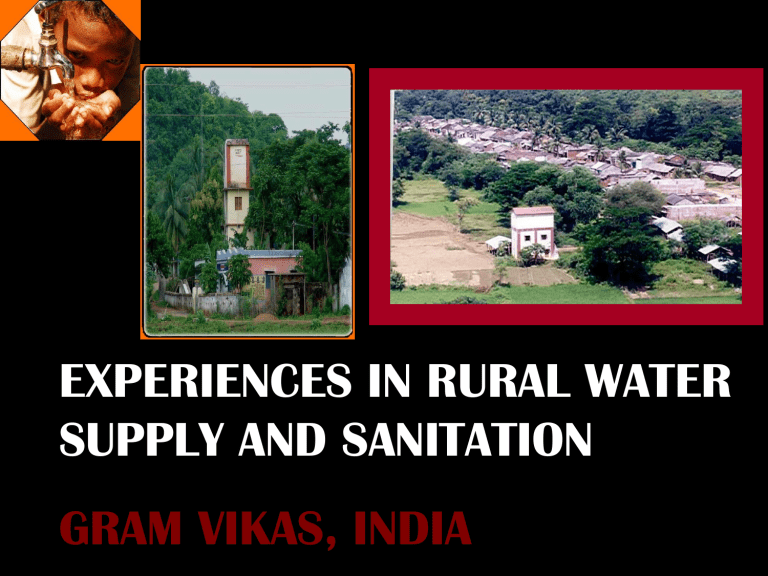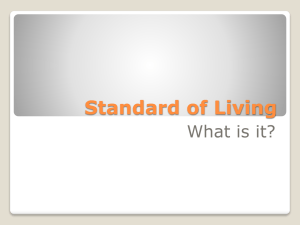EXPERIENCES IN RURAL WATER SUPPLY AND SANITATION GRAM VIKAS, INDIA

EXPERIENCES IN RURAL WATER
SUPPLY AND SANITATION
GRAM VIKAS, INDIA
A familiar scene …
Waiting for the dark..
More than 1.1 billion individuals donot have access to safe drinking water
More than 2.4 billion people donot have access to rudimentary sanitation
India signatory to MDG to reduce by half ……
The search continues ..
Private sector
Demand driven
Capacity building
Community involvement
Appropriate tech .
SANITATION AND COST
ERA OF 80S - SUBSIDY DRIVEN
COST RECOVERY AND AFFORDABILITY
MILLIONS OF PEOPLE CONTINUE TO PAY HIGHER
PRICE FOR SUB STANDARD SERVICES
PROVISION OF SOCIAL COST ESSENTIAL IF ACCESS
TO BASIC SERVICE CONSTITUTE A HUMAN RIGHT
sanitation and
Sustainability
Health perspective- technological solution
Integration with water- ground picture different
Target approach has not helped
Need to create a “ win win” situation
CHA_0023
Bringing
Sanitation&Water supply
Village by
Village
Gram Vikas way
Location of Work
• 22 Districts
• 800 Habitations
50,000 Families
2,50,071 People
Context
80% morbidity in rural India
Due to lack of protected and safe drinking water and sanitation.
94% population in rural orissa have no access to protected water
Less than 1% have access to sanitation facilities
Unprotected water bodies are the breeding grounds for various waterborne ailments.
The daily drudgery doesn't spare anyone
Not even children…
Exclusion is a bane in society
Water and Sanitation
A vehicle for social inclusion
Core Values
Inclusion
Social
Equity
MANTRA
Cost Sharing
Gender
Equity
Sustainability
100% Coverage of all households
• Water and sanitation anchored within local institutional arrangements
•Equal representation of men and women
•Each household contributes an average of
Rs. 1000 ($22) towards corpus fund
People can and will pay for quality but there are social costs
TWIN PIT POUR FLUSH
24 x7 protected piped water supply to houses
• People contribute their labour and local materials and Gram
Vikas pays the cost of external materials (USD
75)
Training in Masonry
WATER TANKS
Ensuring Sustainability
• Institutional mechanisms to enforce and maintain hygienic practices- group monitoring by children, women ..
•
Ensuring all time 100% coverage
•
Identification of maintenance mechanisms, e.g. contribution from harvests; community pisciculture; monthly payments
• Introduction of volumetric pricing at the household level for water
Building Dignity , not just toilets!
Community Capital
•
Inclusive village institutions adopt democratic ways of functioning
• Women gain public space and voice in village decision making process;
•
Capacities to negotiate and bargain with state and other agencies improved- role of contractor eliminated
•
Improvement in health status of women and children
• Improved functioning of schools and increase in enrollment of children.
Results
85% reduction in incidence of water-borne diseases
Corpus fund of over Rs. 50 million
Toilet and bathing rooms constructed for 50246 households in 787villages
Toilets to new households: 359 units
Government development funds of about Rs.56 million accessed annually directly by villages
Over 90% immunisation of children
Over 90% enrolment of children in school; attendance over 80% for girl children
Influencing government policies on sanitation and water supply
CHALLENGES
• 100 PERCENT COVERAGE A TALL
ORDER
• INTEGRATION WITH WATER NOT
THE PRIORITY
• TARGET APPROACH
• CHALLENGE IN WORKING WITH THE
GOVERNMENT
V
I
K
A
S
G
R
A
M
An equitable and sustainable society where people live in peace with dignity


